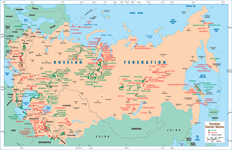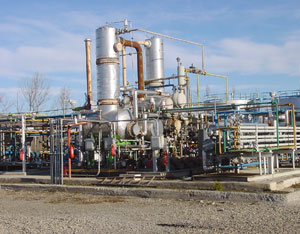FSU/ Eastern Europe: Other FSU Republics
Aug. 2001 Vol. 222 No. 8 International Outlook FSU/EASTERN EUROPE Russia, Turkmenistan, Uzbekistan, Ukraine, Belarus and Lithuania by Alec Mikhalyants , Igor Pol
FSU/EASTERN EUROPERussia, Turkmenistan, Uzbekistan, Ukraine, Belarus and Lithuania by Alec Mikhalyants, Igor Polovets and Alex Chorine, RPI, Inc., a U.S.-Russian consulting firm, Moscow and Los Angeles Other FSU RepublicsBelarus. Since peaking at 160,000 bpd in the 1ate 1970s, Belarussian oil production has declined substantially. In 2000, state-owned operator Belarusneft, which handles all oil output, produced 36,600 bpd, nearly the same volume as in 1999. Belarusneft plans to produce 35,850 bopd in 2001. Associated gas production was 24.8 MMcfd, up 0.5%.
State companies Belarusneft and Belgeologiya are exploring in the Pripjat basin (including the Gomel, Mogilev and Minsk regions). However, discovery of significant new reserves is unlikely. Of 61 known oil reservoirs, 42 are developed. All oil fields are located in the Pripjat basin. Belarus’ oil fields are heavily depleted. Under the current exploratory drilling / enhanced recovery program, about 80% of initial recoverable reserves will be produced by 2010. Georgia. Last November, the president of state oil firm Saknaftoby, Revaz Tevsadze, told local media that the country needs about $450 million invested to increase production during the next five years. He said that Georgia’s goal is to boost oil output to 1.2 million t (24,000 bpd) in 2005. By comparison, Georgian output in 2000 was 2,179 bopd and 6.47 MMcfgd, up 20% and 1,025%, respectively. The number of active oil wells was 136, 18% above 1999’s figure. There were 11 active gas wells, up from two in 1999. There are seven JVs involved in Georgia. Among these, Britain’s CanArgo Energy has been quite active. The firm completed the N98 horizontal sidetrack last August at Ninotsminda field, with stabilized production rates of 220 bopd and 750,000 cfgd. At that same time, CanArgo spudded the N97 well, which was subsequently completed as an oil discovery, testing 515 bpd.
The N97 find was followed by drilling of the N78z discovery. In January, it tested 740 bopd from a 135-ft interval at about 7,870 ft. The first of three deep gas wildcats, N100, was drilling ahead at 9,140 ft in June. The second well of the series, M11, is drilling on the Manavi prospect. Meanwhile, Anadarko Petroleum conducted a seismic survey of its Black Sea concession during fourth-quarter 2000. On the Kaheti Block X, Ramco Energy said that it intends to drill a wildcat this year, either directly as operator or through a farm-out deal. Lithuania. At the end of 2000, Lithuania’s total onshore oil reserves were estimated at 34.9 million bbl. There are 33 oil wells located within 10 oil fields. According to the Ministry of Economy, all 33 were active last year. Lithuania’s oil is produced by four operators: Minijos Nafta, Geonafta, Genciu Nafta and Manifoldas. In 2000, Lithuania produced 6,303 bopd, up 37% from 1999’s level. Minijos Nafta, the largest local producer, operated 16 wells and produced 3,065 bopd. The firms plan to produce close to 10,000 bopd in 2001. Drilling rose to five wells and 38,174 ft, versus one well and 7,959 ft in 1999. Officials predict 12 wells in 2001. They expect 99 mi of 2-D seismic work and 65 sq mi of 3-D surveys. Kyrgyzstan. As expected, the North American firm, Cadima Petroleum, began drilling earlier this year in the Dzhalal-Abad region of southern Kyrgyzstan. In May, Prime Minister Kurmanbek Bakiyev announced that the firm had made an oil discovery, perhaps as much as 70 million bbl. Meanwhile, an Australian enterprise, Ekshen Gidrokarbons Ltd., signed a deal to explore areas in the south. In addition to foreign firms’ efforts, Kyrgyzneftegaz intends to increase its own drilling. Instead of two wells per year, the country could see up to 10 wells annually. Oil output was nearly steady last year, at 1,531 bpd. Gas output was up 28%, at 3.1 MMcfd. Tajikistan. There is very little upstream activity in the country, due principally to a lack of money. In June 2000, Tajik officials held talks with the Iranian government, seeking financial and technical assistance. Oil production was virtually unchanged last year, averaging 366 bpd. Gas output was up slightly, at 3.85 MMcfd. Latvia. In second-quarter 2001, the Ministry of
the Economy launched the country’s first licensing round, covering 1,033 sq mi (2,675 sq km). As unveiled
in London, the round contains seven Baltic Sea blocks that are available for exploration and drilling permits.
Another 66 blocks were made available for reconnaissance licenses. Bids for the two-year reconnaissance
licenses are due by Oct. 31, 2001.
|




